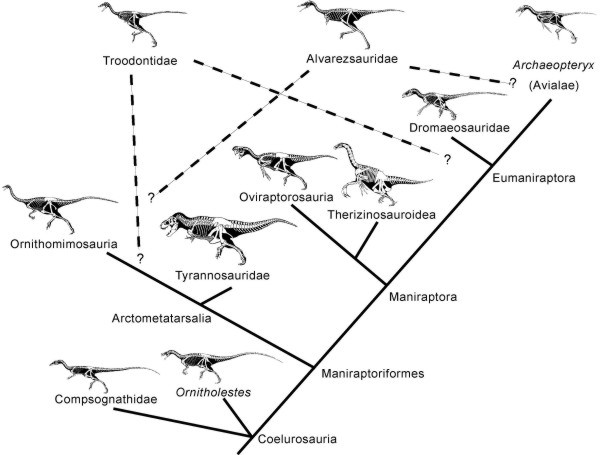GEOL 104 Dinosaurs: A Natural History
Fall Semester 2000
Theropoda II: Tyrants, raptors, ostrich mimics, and more
Coelurosauria includes a wide diversity of forms, including omnivores,
herbivores, and birds!
Coelurosaurs are characterized by:
- Narrow, three-fingered hand
- "Boat-shaped" chevrons for extra tail stiffening
- Tall ascending process of astragalus to absorb stresses of running
- "Protofeathers": filament-like structures covering much of the body

Compsognathidae (less than 1.5 m long) and 2 m long Ornitholestes represent small
basal coelurosaurs. However, 8 m long Dryptosaurus was also a primitive coelurosaur.
The more advanced coelurosaurs form a clade Maniraptoriformes, characterized by:
- Enlarged brain size compared to other dinosaurs
- Bony secondary palate (roof of mouth), to absorb additional stresses
Maniraptoriform interrelationships are subject of a lot of study, and some disagreement.
There is general agreement over the position of Ornithomimosauria (ostrich dinosaurs),
Oviraptorosauria, Dromaeosauridae ("raptors"), and Avialae (birds), but
less agreement over Tyrannosauridae (tyrant dinosaurs), Therizinosauroidea,
Troodontidae, and Alvarezsauridae (the last two are particularly problematic).
The solution used here, and shown above, comes from my own research.
Maniraptoriformes is divided into two main clades, Arctometatarsalia and Manraptora.
Arctometatarsalians are characterized by:
- Incisor-like premaxillary teeth for nipping
- Very long tibiae and metatari (also in troodontids and some alvarezsaurids and
oviraptorosaurs)
- An arctometatarsus:
- Metatarsus where metatarsal III forms a wedge distally, but pinches out proximally
- Shown to be a good shock absorber for fast running
- Also found in troodontids and some alvareszaurids and oviraptorosaurs
There are two main clades of arctometatarsalians, with very similar hindquarters but very
different front ends:
- Ornithomimosauria (name means "bird mimic dinosaurs", but often called
"ostrich mimics" because of their general similarity to ostriches in shape and size)
- Characterized by:
- Long necks and small heads
- Long snouts which are toothless in the advanced forms (although primitive
ornithomimosaurs had lots of teeth)
- Long arms with metacarpals all the same length and hooking-and-clamping
(rather than grasping) hands
- Were probably fast running omnivores, eating small vertebrates, invertebrates, and plants
- May have been the fastest Mesozoic dinosaurs
- Known from the Early Cretaceous of Europe and Asia, and the Late Cretaceous of Asia and
western North America
- Most were about ostrich-sized or larger, but some were small and one was as big as
Tyrannosaurus
- Tyrannosauridae ("tyrant dinosaurs")
- Characterized by:
- Large skull size
- Expanded area for jaw and neck muscle attachements
- Teeth which are thick from side to side (not steak knife-like, as in most theropods)
- Reduced forelimbs with only two fingers (digits I & II)
- Were probably fast running carnivores, eating large dinosaurs
- Known from the Early Cretaceous of Asia and the Late Cretaceous of Asia and western North
America
- Began fairly small (5 m or so), but in Late Cretaceous reached giant size
Maniraptora ("hand snatchers") are characterized by:
- Enlarged sternal plates
- Increased forelimb length
- Enlarged semilunate carpals, perhaps to compensate for enlarged forelimb and hand
- Shoulder joints that faced sideways rather than backwards (as in most dinosaurs)
Maniraptorans are very diverse. The major clades are:
- Oviraptorosauria, with short boxy skulls that are toothless in all
but the most primitive form
- Were probably omnivores, eating both small vertebrates and plants
- Found in many parts of the world in Cretaceous, but most common in Asia
- Most were smaller than humans
- Therizinosauroidea, with long necks, prosauropod-like heads with
leaf-shaped teeth, shortened tibiae and metatarsi, and backwards-pointing
pubes
- Were almost certainly slow-moving herbivores, with big guts
- May have defended themselves with powerful claws
- Most were bigger than humans; one rivalled Tyrannosaurus in size and had 1 m
long manual claws!
- Eumaniraptora ("true maniraptorans")
- Characterized by:
- Backwards-pointing pubis (in this case, associated with change in leg muscles)
- Tails which were very mobile proximally but very stiff distally
- Retractable pedal digit II, often tipped with a big sickle claw
- Eumaniraptorans include Avialae (subject of next lecture)
and Dromaeosauridae
- Dromaeosaurids, or "raptors", were carnivorous, had tails stiffened by long
rods and extremely large sickle claws
- Dromaeosaurids seem to have shorter, stockier legs than a lot of other predator theropods:
may have been more cat-like (agile ambush predators) than dog-like (fast pursuit predators)
- Range throughout Cretaceous (some possible teeth from Middle Jurassic)
- Best known from 4 m long Deinonychus of the late Early Cretaceous of North
America and 2 m long (at most) Velociraptor of the Late Cretaceous of Mongolia
- Dromaeosaurids may have hunted in groups
Two particularly problematic groups:
- Troodontids:
- Had short arms, like primitive coelurosaurs
- Had arctometatarsi, long legs, and a specialized expanded pocket in the
braincase like ornithomimosaurs
- Had leaf-shaped teeth like therizinosauroids
- Had tails which were very mobile at the base and retractable pedal digit II with
sickle claws like in eumaniraptorans
- Famous for large brain size, but other maniraptoriforms seem comparably brainy
- Known from Middle Jurassic teeth, but best known from Cretaceous of Asia and North
America
- Smaller than humans
- Seem to have been omnivorous, eating small vertebrates (including baby dinosaurs),
but also plants
- Alvarezsaurids:
- Had very short arms with only manual digit I, unlike all other theropods
- Skull and small tooth shape resembles primitive ornithomimosaurs
- Pubis points backwards and skull has joint in front of eyes as in avialians
- Known from South America, North America, Asia, and possibly Australia in the Cretaceous
- Very small: 1-2 m long
- Diet uncertain: maybe insect eaters
More work still needs to be done to sort the relationships of these dinosaurs out.
Nevertheless, it is within the coelurosaurs that the birds arose.
To Next Lecture.
To Previous Lecture.
To Syllabus.
